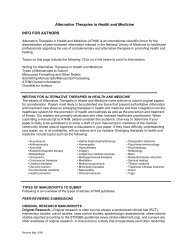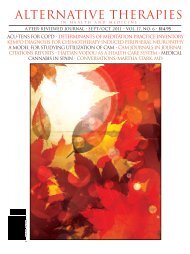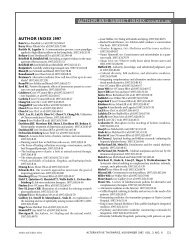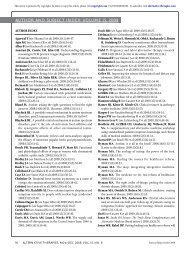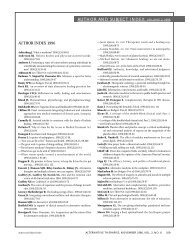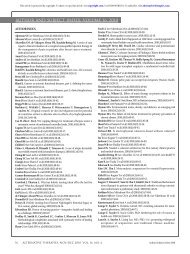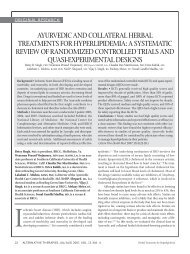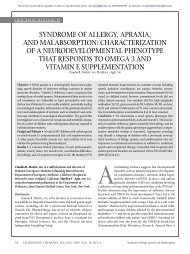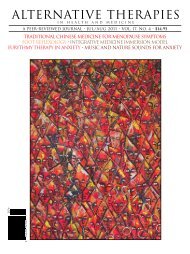Alternative Therapies In Health And Medicine
Alternative Therapies In Health And Medicine
Alternative Therapies In Health And Medicine
You also want an ePaper? Increase the reach of your titles
YUMPU automatically turns print PDFs into web optimized ePapers that Google loves.
or discontinue HT because of perceived risks, medical contraindications,<br />
or a general reluctance to use unnatural exogenous<br />
hormones. 10,11 Concerns about the safety of estrogen-based hormone<br />
replacement therapy such as risk of breast cancer, coronary heart<br />
disease, and stroke 12,13 have led to demands for other options, and<br />
many women are now actively seeking alternative approaches.<br />
Herbal medicine and acupuncture have been used for centuries<br />
in China to treat menopausal symptoms and are still popular.<br />
Clinical trials in China have manifested significant efficacy of Chinese<br />
herbal medicine (CHM) like Kun Bao Wan (KBW) in alleviating<br />
menopausal symptoms in Chinese women. 14-18 Also, many clinical trials<br />
suggest the positive effects of acupuncture in decreasing menopause-related<br />
symptoms. 19-23<br />
This study was designed to assess the efficacy of KBW, which is<br />
a mixture of many Chinese medicinal herbs, in comparison with two<br />
other study groups, HT and acupuncture plus CHM, in relieving the<br />
menopausal symptoms in Chinese peri- and postmenopausal<br />
women. The women met the Chinese medicine diagnosis pattern of<br />
kidney and liver yin deficiency accompanied by liver yang hyperactivity<br />
as a determining inclusion criterion.<br />
METHODS<br />
Participants<br />
This clinical trial was carried out during a 14-month period<br />
between June 2008 and July 2009 at Dongzhimen Hospital, which is<br />
affiliated with the Beijing University of Chinese <strong>Medicine</strong> and Peking<br />
University People Hospital. Ninety-seven Chinese women who were<br />
referred to the clinic of gynecology for their menopause-related<br />
symptoms were screened for inclusion and exclusion criteria. Peri- or<br />
postmenopausal women who showed at least three of the 11<br />
Kupperman <strong>In</strong>dex symptoms—hot flushes, paresthesia (the feeling<br />
of “pins and needles” on one’s skin), insomnia, nervousness, melancholia,<br />
vertigo, weakness, arthralgia or myalgia, headache, palpitations,<br />
and formication (the sensation of insects crawling on or under<br />
one’s skin)—were entered into the study provided that they were at<br />
least 40 years old. Perimenopausal women were included if they<br />
exhibited menstrual irregularities or a rise in the level of follicle-stimulating<br />
hormone (FSH) greater than 10 IU/L. The inclusion criterion<br />
for Chinese medicine diagnosis was the pattern of kidney and liver<br />
yin deficiency accompanied by liver yang hyperactivity. A “red<br />
tongue without fur” was present in all patients. The Chinese medicine<br />
syndrome differentiation was established by only one Chinese<br />
medicine doctor in order to ensure uniform diagnosis. Those taking<br />
medications that influenced the rate of hot flush (systemic HT, selective<br />
serotonin reuptake inhibitors) were included only after a washout<br />
period of 8 weeks (4 weeks for those taking local estradiol [E2]<br />
preparations). Gynecological examination and laboratory tests were<br />
carried out to screen the patients for any organic diseases of the<br />
reproductive system. Patients were asked whether they were currently<br />
under medical treatment or suffering from breast cancer or serious<br />
cardiac, renal, metabolic, endocrine, or hepatic disease. After the<br />
application of inclusion and exclusion criteria, 25 women were<br />
excluded and 72 were entered into the study and randomized into<br />
three groups. Of the included patients, 57 chose to continue during<br />
the course of treatment, but 15 patients dropped out. Participants<br />
were randomized into three equal groups using a randomization<br />
chart. Randomization assignments were placed in a table visible to<br />
be assigned sequentially. Among 57 patients who remained in the<br />
study to the end, 22 were in the CHM group, 20 were in the acupuncture<br />
plus CHM (ACU + CHM) group, and 15 were in the HT group<br />
(Figure). Blinding women to their treatment assignment was impossible<br />
in this study. The study period consisted of 2 consecutive<br />
months. We attempted to measure the participants’ compliance with<br />
assigned study treatment by calling them regularly. The study was<br />
thoroughly conducted in line with the Declaration of Helsinki. The<br />
aim and methodology of the study were explained to the patients,<br />
and informed consent was obtained. Blinded study personnel asked<br />
the patients about their symptoms.<br />
Proposed<br />
sample size:<br />
n=60<br />
CHM group<br />
(n=24)<br />
Received oral KBW<br />
5 g, recommended<br />
with warm water,<br />
twice a day<br />
for 2 consecutive<br />
months<br />
Missed cases (n=2)<br />
Analyzed (n=22)<br />
Referred to gynecology clinic and screened<br />
for inclusion criteria (n=97)<br />
Entered the study and randomized<br />
(n=72)<br />
ACU+CHM group<br />
(n=24)<br />
Received oral KBW<br />
5 g, recommended<br />
with warm water,<br />
twice a day<br />
for 2 consecutive<br />
months<br />
+<br />
10 sessions of<br />
acupuncture within<br />
the 2 months of<br />
receiving KBW<br />
Missed cases (n=4)<br />
Analyzed (n=20)<br />
Figure Study Design<br />
HT group<br />
(n=24)<br />
Received oral<br />
hormone therapy<br />
CE 0.625 mg/d<br />
(28 days)<br />
+ MPA 4 mg/d<br />
in the last 12 days,<br />
totally for 2 months<br />
or<br />
CE 0.625 mg/day<br />
+ MPA 2 mg/d<br />
unremitting<br />
totally for 2 months<br />
Missed cases (n=9)<br />
Analyzed (n=15)<br />
Abbreviations: CHM, Chinese herbal medicine; KBW, Kun Bao Wan; ACU,<br />
acupuncture; HT, hormone therapy; CE, conjugated estrogen; MPA,<br />
medroxyprogesterone acetate.<br />
Administration<br />
The ingredients of KBW are as follows: Fructus Ligustri Lucidi<br />
4.13%; Radix Paeoniae Lactiflorae (wild-crafted form) 4.13%; Radix<br />
Paeoniae Lactiflorae (cultivated form) 8.25%; Radix Rehmanniae 4.13%;<br />
Fructus Rubi 2.75%; Radix Angelicae sinensis 2.75%; Semen Cuscutae<br />
Chinensis 2.75%; Radix et Caulis Jixueteng 8.25%; Lycii Fructus 2.75%;<br />
Semen Zizyphi Spinosae 1.38%; Radix Scutellariae Baicalensis 4.13%; Flos<br />
Chrysanthemi Morifolii 4.13%; Herba Ecliptae 5.5%; Radix Adenophonrae<br />
4.13%; Folium Mori Albae 2.75%; Radix Cynanchi Baiwei 4.13%;<br />
Anemarrhena Rhizome 4.13%; Radix Polygoni Multiflori 2.75%; Herba<br />
Dendrobii 4.13%; Lycii Cortex 4.13%; Colla Plastrum Testudinis 2.06%;<br />
Menopause: Traditional Chinese <strong>Medicine</strong> vs Hormone Therapy<br />
ALTERNATIVE THERAPIES, jul/aug 2011, VOL. 17, NO. 4 49



